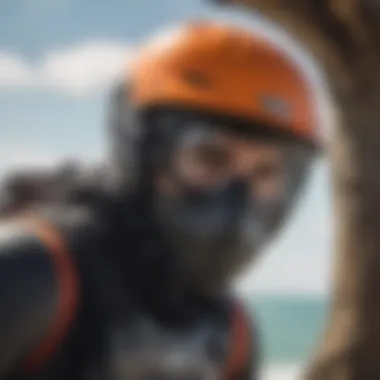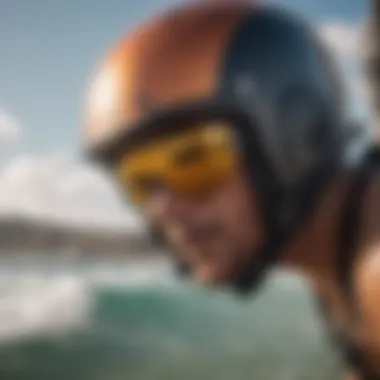Exploring V2 Helmets: Safety and Innovation in Kiteboarding


Intro
When you think about kiteboarding, the thrill of gliding across water, the rush of wind in your hair, and the potential for breathtaking stunts come to mind. But often overlooked is the importance of head protection in such an exhilarating sport. Enter the V2 helmet, a specialized piece of gear that claims to enhance both safety and performance on the water. In this article, we’ll take a closer look at V2 helmets, understanding their evolution, unique features, and essential benefits for kiteboarders.
The journey of helmet innovation is important to consider. From the early days of rudimentary designs to the sophisticated V2 helmets available now, protective gear for extreme sports has come a long way. This guide promises to unpack not just the specifications, but how these helmets directly impact the kiteboarding experience. With insights on safety regulations, user perspectives, and future advancements, we cater to all—novices testing the waters and seasoned kiteboarders looking to upgrade their gear.
Let’s dive into the Gear Insights, as understanding the equipment is the cornerstone to ensuring both safety and performance in kiteboarding.
The Evolution of Helmets in Water Sports
Understanding how helmets have evolved in water sports, particularly in kiteboarding, is about more than just safety or style; it’s a reflection of the maturation of the sport itself. In earlier times, helmets were basic and often overlooked, considered just an accessory rather than an essential piece of equipment. However, as kiteboarding gained popularity, the narrative shifted dramatically. A helmet is no longer just something to throw on before heading out to ride the waves; it’s a commitment to safety and better performance on the water.
Historical Context
Going back in time, the concept of protective gear in water sports wasn't given the attention it deserved. The early kiteboarders used what was available, often modifying skate or bicycle helmets for their own needs. These helmets were clunky and provided little water resistance, making them impractical against the challenges posed by both the speed and fluidity of water. There was a significant learning curve, and many riders faced injuries simply because the right protective gear wasn’t available or wasn’t taken seriously enough. As time went by, incidents prompted a shift in thought. Riders began advocating for better protection, leading to initial designs where form and function started to harmonize more.
Technological Advancements
Fast forward to today, and we see a whole different ballgame. Materials like carbon fiber and foam composites are game changers. These advanced materials are both lightweight and remarkably strong. Such innovations have enabled manufacturers to develop helmets that not only protect riders but also enhance their experience on the water. Aerodynamics is another crucial area where technology has made strides. Modern helmets are crafted to minimize drag, allowing kiteboarders to maximize their speed and agility. Moreover, ventilation systems have been incorporated to ensure that riders remain comfortable, even on the hottest days. Plenty of thought has gone into designing helmets that withstand impact while feeling good to wear, thus solving a host of issues that riders experienced previously.
Prologue of V2 Helmets
The introduction of V2 helmets brought a much-needed evolution in this ongoing saga. Unlike their predecessors, V2 helmets are engineered with the specific requirements of kiteboarding in mind. The V2 helmets provide comprehensive coverage while ensuring there’s no compromise on visibility or comfort. Riders can choose from various designs, ranging from sleek to sporty, while enjoying features like customizable padding and enhanced audio capabilities, thanks to integrated speakers. Beyond aesthetics, safety has always been the focal point. V2 helmets meet rigorous safety standards that are both globally recognized and tested, inevitably giving riders the necessary peace of mind. This evolution in helmet design resonates with kiteboarders of all skill levels, from ambitious newbies to seasoned pros. It’s clear that choosing the right helmet is no longer an afterthought, but a key factor in enjoying the thrilling world of kiteboarding.
Understanding V2 Helmets
Understanding V2 helmets is key for kiteboarding enthusiasts aiming to enhance their safety and performance on the water. These helmets are not just a protective gear but also serve as a bridge between style and function. Riders need to consider various aspects like design features, fit, weight, and comfort, all of which contribute to an optimized experience.
Design Features of V2 Helmets
Materials Used
When it comes to materials used in V2 helmets, durability and lightness are the game-changers. Most V2 helmets are crafted from advanced thermoplastic or lightweight carbon fiber. Carbon fiber, for instance, is recognized for its high strength-to-weight ratio, making it a favored choice. It provides robust protection against impacts while ensuring the helmet feels barely there, a crucial factor for kiteboarders who value agility. However, while carbon fiber is costly, its performance in preventing damage is well worth the investment.
- Unique Feature: The foam padding inside, often made of EPS (expanded polystyrene), adds another layer of safety by crumpling during impact, absorbing energy and safeguarding the rider's head.
Aerodynamics
Aerodynamics plays a major role in helmet design, particularly for those surfing the winds and waves. V2 helmets often feature streamlined shapes engineered to minimize drag. Its sleek design helps riders maintain speed without the wind acting as a brake, which is vital for high-speed maneuvers.
An aerodynamic shell can help reduce wind noise too, making communication while riding smoother. However, balancing aerodynamics and weight is critical; an overly aerodynamic design can sometimes lead to a heavier helmet that might be less comfortable over prolonged use.
Ventilation Systems
Ventilation is another essential feature that directly impacts comfort during hot days on the water. Many V2 helmets come equipped with strategically placed vents. These vents allow air flow in and out, preventing the buildup of heat inside the helmet.
A well-ventilated helmet reduces sweat accumulation, keeping riders fresher and focused. Too many vents, though, may compromise the helmet’s structural integrity. So, finding that sweet spot is beneficial.


Size and Fit Considerations
Measurement Guide
When selecting a helmet, getting the right fit starts with accurate measurement. A measurement guide typically involves measuring the circumference of the head about an inch above the eyebrows. A snug fit is crucial; loose helmets can move during impacts, compromising their effectiveness.
The guide can provide recommendations on size ranges based on these measurements, often listed in centimeters and inches. While opting for a larger size might seem like an easier approach for comfort, it can lead to safety concerns.
Adjustability Options
Adjustable options in V2 helmets introduce personalized fit, accommodating different head shapes and sizes. Many models, for instance, feature dial-fit systems that allow riders to tighten or loosen their helmets effortlessly. This adjustability enhances the comfort level significantly, reducing the chances of pressure points.
Moreover, adjustable straps enable precise positioning, securing the helmet in place even during intense activities. A downside could be that the mechanisms might be less effective under extreme conditions, so regularly checking the adjustments is smart.
Weight and Comfort
Weight and comfort are intertwined aspects that can make or break the riding experience. Lightweight materials often combined with ergonomic designs help ensure that riders don’t feel weighed down. Finding a helmet that strikes a balance between protection and comfort is crucial. Riders usually report that a comfortable fit allows for longer sessions without fatigue.
Ultimately, while choosing a V2 helmet, considering how it feels during both action and stillness can significantly influence the overall kiteboarding experience.
Safety Features of V2 Helmets
When it comes to kiteboarding, safety should be at the forefront of any rider’s mind. V2 helmets are designed with multiple safety features that cater to the unique demands of this exhilarating sport. Understanding these features not only enhances the experience but also assures riders that they are protected against potential hazards.
Impact Resistance
The first line of defense in any helmet is its ability to resist impact. V2 helmets are crafted using high-quality materials engineered to absorb and disperse energy upon impact. This characteristic is crucial because, during a fall or collision, the helmet serves as a barrier between the rider's head and the harsh realities of water or board strikes. The effectiveness of impact resistance varies between models; hence, it's important to consider not just the materials used but also how they are constructed.
For example, some V2 helmets use a multi-density foam design, which can reduce the risks associated with various impact levels. This means that whether a rider takes a minor tumble or faces a more serious situation, the helmet is primed to cushion the blow effectively.
Chin Strap and Retention Systems
The chin strap of a helmet is a detail often overlooked yet plays a critical role in ensuring safety. For V2 helmets, the chin strap and retention system are engineered for a snug fit without compromising comfort. An improperly fitted helmet can fly off during a wipeout, rendering it useless.
Most V2 models feature adjustable chin straps, allowing riders to customize the fit based on their head shape and personal preference. Some even integrate quick-release buckles, which can be a blessing during incidents that require a rapid exit. The security offered by these retention systems can be the difference between a safe ride and an unfortunate accident.
Certification and Standards
In the world of helmets, not all certifications are created equal. Understanding certification and standards can help kiteboarders make informed decisions about the safety of their gear, leading to a safer experience on the water.
Global Standards
Global standards like the ASTM, CEN, and EN provide crucial guidelines for helmet safety. Each of these standards establishes testing methods and performance levels that helmets must meet or exceed to be deemed acceptable for use. The presence of these certifications on V2 helmets denotes a level of reliability that riders can trust.
One key characteristic of these global standards is their rigorous testing procedures, which validate a helmet’s impact resistance and overall durability. This ensures that only helmets meeting such marks can be sold, providing peace of mind for users. Additionally, these standards evolve over time, requiring manufacturers to keep up with the latest safety technologies and developments. Riders favor these certifications because they signify that the helmet has undergone real-world testing, unlike some generic alternatives that may look good but lack proven safety features.
Testing Procedures
Testing procedures are a cornerstone of helmet certification and reflect how effectively a helmet can take on real-world scenarios. Most helmets undergo a battery of tests that assess not just impact resistance, but also comfort, fit, and retention. For V2 helmets, these testing procedures ensure they meet stringent safety regulations.


An essential aspect of these procedures involves simulating various impact conditions to observe how well the helmet performs. Such detailed scrutiny allows manufacturers to fine-tune their designs, often leading to innovations in safety technology. However, while testing is a valuable aspect of helmet design, it's worth noting that not all manufacturers conduct tests at the same level of rigor. This discrepancy highlights the importance of purchasing helmets from reputable brands that abide by recognized testing protocols.
"A helmet is not just a piece of gear; it's an investment in your personal safety that, quite literally, can save your life."
In summary, the safety features of V2 helmets operate on multiple levels to provide riders with a secure experience. Understanding these aspects—from impact resistance to stringent testing standards—empowers kiteboarders to make educated choices about the helmets they wear, enhancing their safety and confidence on each outing.
User Experiences and Reviews
Understanding user experiences and reviews is pivotal when discussing V2 helmets in the kiteboarding realm. These insights can foster a better grasp of how these helmets perform in real-world conditions, beyond just the specifications provided by manufacturers. Feedback from fellow kiteboarders often sheds light on how a piece of equipment truly functions, which can be incredibly valuable for potential buyers. Most importantly, reviews can pinpoint areas where these helmets shine and where they may fall short, ultimately guiding informed decision-making.
Feedback from Intermediate Riders
When looking at the insights from intermediate kiteboarders, several recurring themes surface. Many riders value comfort alongside functionality. It’s often noted that V2 helmets excel in providing both, with their lightweight design not compromising safety. Riders appreciate helmets that don’t feel burdensome during extended sessions on the water. They mention that proper fit is crucial; if a helmet feels too loose or tight, it can distract from the ride.
"Comfort is as crucial as safety. If a helmet gets in the way, it’s of little use for me," shared one rider in a discussion forum on reddit.com.
Additionally, the interim riders frequently highlight the importance of visibility. When glancing over their shoulder while kiteboarding, a well-designed helmet should not obstruct sightlines. This feedback stresses the need for a balanced design in V2 helmets that allows for both safety and an unobstructed field of vision.
Expert Opinions
Experts in the field often lend significant weight to the conversation surrounding helmet technology. Their assessments can provide insights that novices may miss. For instance, many kitesurfing professionals commend V2 helmets for their robust impact resistance. They note that the use of advanced materials not only protects vital areas but also enhances overall durability against the harsh marine environment.
Furthermore, experts emphasize the importance of certification. They reiterate that choosing helmets meeting Codex safety standards can make all the difference, particularly in ensuring rider safety during rigorous maneuvers. As one expert stated in an article on britannica.com, "Quality helmets can significantly mitigate the risks associated with high-speed crashes during kiteboarding."
The practicality of venting systems is another area experts often mention. They advocate for ventilation that maximizes airflow while maintaining structural integrity, indicating that a proper balance can lead to unhindered performance in heat. It’s clear that these insights help users distinguish between the myriad options on the market.
Common Issues and Resolutions
Like any product, V2 helmets aren't without their quirks. One common issue cited by users is the potential for neck fatigue during prolonged use. Riders often mention that if a helmet is slightly heavier than average or doesn’t fit snugly, it can create discomfort. A simple resolution is to ensure that you’re selecting the right size or considering helmets with a more ergonomic design.
Another noted concern involves the chin strap and its retention mechanism. Some users have reported that poorly designed straps can lead to annoying adjustments mid-session. The remedy here often lies in exploring different adjustment options before purchase or paying attention to user reviews highlighting adjustable systems.
Moreover, cleaning and maintenance have emerged as common topics among users. Some find it challenging to keep their helmets fresh, particularly if they ride frequently in saltwater conditions. A thoughtful tip is to rinse the helmet with fresh water after every session to mitigate buildup, which can prolong its life.
In summary, informed perspectives from current users and experts can dramatically influence one’s understanding of V2 helmets. Not only do they highlight the advantages and drawbacks, but they also pave the way toward better choices for both safety and performance in kiteboarding.
Maintenance and Care of V2 Helmets
Taking proper care of V2 helmets is more than a tedious chore; it’s essential for ensuring safety and longevity. Helmets endure a lot during kiteboarding, from salty water and harmful UV rays to rough storage conditions. Ignoring maintenance might not only compromise the helmet's performance but can also put you at risk while enjoying your time on the water. Thus, understanding how to correctly maintain your V2 helmet can significantly enhance your overall experience and safety.
Cleaning Techniques
Keeping your V2 helmet clean is crucial, not just for aesthetics but also for functionality. Dirt and salt can gather in places you might not think about, potentially degrading the materials over time. Here are some handy techniques:
- Freshwater rinse: After each use, especially in saltwater, rinse your helmet with freshwater. This simple step helps wash away salt and dirt that can cause build-up.
- Mild soap solution: Use a light soap mixed with water for deeper cleaning. Avoid harsh chemicals as they can ruin the helmet's materials. A soft cloth or a non-abrasive sponge works well for this.
- Dry it off carefully: Once cleaned, allow your helmet to air-dry in a shaded space. Direct sunlight can damage the materials, causing potential warping.
"A clean helmet is a happy helmet. Taking the time to maintain it can save you costs down the line."
- Check the padding: Make it a habit to inspect the padding for wear and tear. If it seems compacted or excessively dirty, consider replacing it to maintain comfort and protection.


Storage Recommendations
Proper storage can lengthen the lifespan of a V2 helmet. The way you store it can prevent damage and keep it in working condition:
- Avoid heated environments: Storing your helmet in a hot car or near heat sources is a no-go. High temperatures can warp the shape or damage the materials.
- Use a dedicated bag: Consider a helmet bag designed specifically for it. This not only keeps it safe from scratches but also protects it from dust and elements when it’s not in use.
- Store it upright: If possible, keep the helmet in an upright position. This prevents any accidental drops or deformities that can occur when it’s laid flat.
- Regular checks: Make a habit of checking your helmet at intervals. Look for cracks and worn-out straps. Regular checks can prevent unexpected issues when you’re about to hit the waves.
By adopting these practices, you ensure that your V2 helmet is in the best shape possible for your kiteboarding adventures. Taking care of your gear reflects your commitment to the sport and your safety.
The Future of Helmet Technology
The realm of helmet technology is advancing rapidly, offering kiteboarders unprecedented levels of safety and performance. The importance of this subject lies not only in enhancing user experience but also in addressing growing concerns around safety standards and environmental impact. Kiteboarders, whether they are recreational enthusiasts or seasoned professionals, require equipment that prioritizes protection without sacrificing comfort or usability. The future of helmet design is promising, with innovative materials, smart integrations, and sustainable practices shaping a new generation of protective gear. As we dig deeper into these trends, kiteboarders can anticipate more tailored options that cater specifically to their needs.
Innovative Materials
Recent innovations in materials have ushered in a transformative era for helmet technology. The days of heavy, bulky helmets are fading as manufacturers explore lightweight alternatives that still offer protection. Some of the most exciting developments include:
- Carbon Fiber: Renowned for its incredible strength-to-weight ratio, carbon fiber is becoming a staple in high-performance helmets. By utilizing carbon fiber, manufacturers achieve a combination of durability and comfort—a key factor for kiteboarders who spend hours on the water.
- Expanded Polypropylene (EPP): EPP foam is gaining traction due to its excellent energy-absorbing properties. This material not only minimizes the impact during an accident but also recovers its shape after deformation, ensuring the helmet maintains its integrity over time.
- Bio-based Plastics: With an increasing focus on sustainability, some brands are beginning to explore bio-based plastics derived from renewable resources. These materials provide similar protective benefits while reducing the overall environmental footprint.
These materials are not just about safety; they offer improved aerodynamics and comfort features such as moisture-wicking liners and adaptable fit systems. Incorporating these advancements assists riders in their performance while reassuring them of their safety on rugged waters.
Smart Helmets and Technology Integration
As technology continues to be woven into the fabric of our lives, it’s no surprise that smart helmets are making waves in the watersport scene. What exactly do smart helmets offer? Consider these benefits:
- Built-in Communication Systems: Seamlessly connecting with fellow riders can enhance safety and coordination during group sessions. With integrated Bluetooth technology, riders can communicate effortlessly, making it easier to coordinate tricky maneuvers or guide beginners.
- GPS and Performance Tracking: Imagine monitoring your session's stats, such as speed and jump height, right from your helmet. This data is invaluable for both learning and honing skills. Some helmets even feature navigation capabilities that guide you back to shore, ensuring safety alongside performance.
- Emergency Features: An alarming yet essential inclusion is the emergency alert system. In case of an accident, a smart helmet can send alerts to emergency contacts. This could potentially save lives by ensuring swift response to situations that could otherwise spiral out of control.
While these integrations present exciting possibilities, they also highlight the need for updates in safety guidelines to incorporate these new technologies adequately.
Sustainability in Helmet Design
Sustainability is becoming a critical focal point in product development across industries, and helmet design is no exception. As kiteboarders and manufacturers alike become more environmentally conscious, integrating eco-friendly practices into helmet production is essential for the future. Notable strategies include:
- Sustainable Sourcing: Brands aim to reduce their carbon footprint by using materials that are sustainably sourced or repurposed. This helps not only to protect the environment but also appeals to eco-conscious consumers.
- End-of-Life Programs: Manufacturers are increasingly adopting take-back programs, allowing customers to return old helmets for recycling or repurposing. This circular approach reduces waste and encourages responsible consumerism.
- Eco-Friendly Packaging: Minimizing unnecessary packaging and opting for recyclable materials is another small yet impactful step manufacturers can take. Kiteboarders can positively influence the market by supporting brands that prioritize sustainability in their operations.
This shift toward sustainability is not just good for the planet; it also appeals to the ethical standards of consumers, creating a new generation of kiteboarders who care about the gear they use.
Embracing innovative materials, smart integrations, and sustainable practices is crucial in shaping the future of helmet technology. By staying informed, kiteboarders can ensure they are equipped with the best gear possible while being mindful of their environmental impact.
End: The Importance of Choosing the Right Helmet
Selecting the appropriate helmet for kiteboarding is not just a matter of preference but a fundamental aspect of ensuring safety and enhancing performance on the water. A kiteboarder faces unique challenges, with variable wind and water conditions, making the right headgear essential. V2 helmets are specially crafted to meet the demands of this sport, combining cutting-edge technology with user-centric design to provide a balance of protection, comfort, and functionality.
Summation of Key Points
- Safety First: Choosing a helmet that adheres to established safety standards can significantly reduce the risk of head injuries during accidents. V2 helmets often come with certifications that guarantee their ability to absorb impact effectively.
- Fit and Comfort: A helmet that fits well is crucial. An ill-fitting helmet may shift during use, reducing its effectiveness. V2 helmets often feature adjustable designs that allow for a snug fit, ensuring that they stay securely in place even during intense maneuvers.
- Features and Technology: Modern V2 helmets incorporate features like lightweight materials, advanced ventilation systems, and aerodynamics designed to tackle the kiteboarding environment. These elements can improve comfort, reducing fatigue during prolonged sessions on the water.
These factors combined emphasize that a thoughtful helmet selection process can enhance not just the rider’s safety but also their enjoyment of the sport.
Encouragement for Personal Research
While this article provides a thorough overview of V2 helmets, it's vital for kiteboarders, instructors, and enthusiasts to engage in personal research. The world of helmet technology is continuously evolving, and various brands may offer specific features that cater to individual preferences or requirements.
- Check user reviews on platforms like Reddit or Facebook to gather insights from real-world experiences.
- Explore expert opinions and articles on sports safety, expanding beyond V2 helmets to understand broader trends in helmet design.
- When visiting local shops, take the opportunity to try on different helmets, noting the feel and fit, as personal comfort varies dramatically from one individual to another.
In short, finding the right helmet involves wearing different options, reading up on recent innovations, and remembering that safety always trumps style. Making a well-informed decision will ultimately contribute to a more enjoyable and secure kiteboarding experience.















